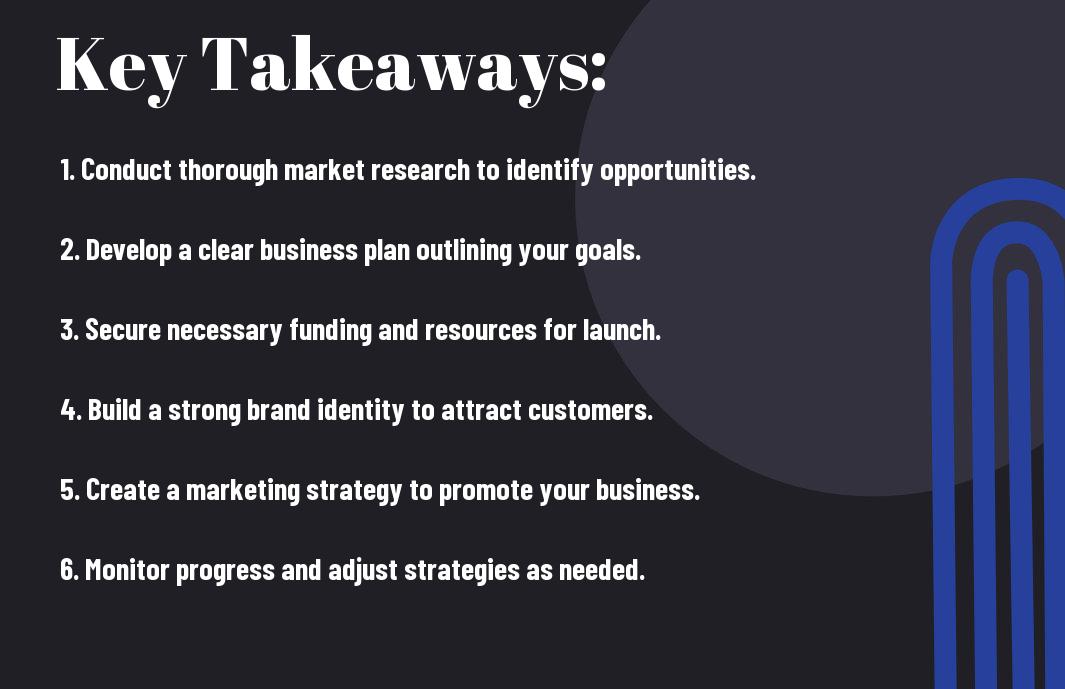
Ideas are the foundation of any successful business, but transforming them into reality requires a structured approach. As you launch on your entrepreneurial journey, understanding the crucial steps can significantly enhance your chances of success. This blog post will guide you through the vital stages of planning, executing, and launching your business, ensuring that you strategically navigate the complexities of entrepreneurship. From refining your concept to implementing effective marketing strategies, each step is pivotal to bringing your vision to life.

Identifying Your Business Idea
Before exploring into the world of entrepreneurship, you need to pinpoint a business idea that truly resonates with your passion and the market’s needs. This process requires introspection and creativity, as well as a keen understanding of the industries you are interested in. Explore your interests, analyze trends, and think about the problems you can solve for potential customers. Your idea should not only excite you but also have potential demand in the market.
Market Research
Behind every successful business idea lies thorough market research. This phase allows you to understand who your target audience is, what they truly need, and how your potential competitors are addressing those needs. By gathering insights through surveys, interviews, or existing market data, you can validate your idea and identify any gaps that can be filled.
Refining Your Concept
Market feedback and insights are important for honing your business idea. Your initial concept may require adjustments to ensure it meets market demands and stands out among competitors. Engaging with potential customers and soliciting their opinions can help shape your offering, making it more appealing and viable in the marketplace.
Identifying your unique value proposition is part of refining your concept. Think about what sets your idea apart and how it can solve a specific problem for your target audience. Use this feedback to iterate and enhance your business model, ensuring it aligns with customer preferences and market trends. By continuously adapting your concept based on insights, you’ll lay a strong foundation for a successful launch.
Creating a Business Plan
If you’re serious about launching your business, a well-thought-out business plan is crucial. This document not only outlines your vision but also serves as a roadmap for achieving your goals. It will help you identify your target market, set realistic objectives, and navigate potential challenges. Investing time in crafting a solid business plan will save you headaches later and elevate your chances of success.
Executive Summary
Around the essence of your business plan lies the executive summary, a snapshot that captures the key elements of your venture. This section provides potential investors or stakeholders with a quick overview, highlighting your business objectives, mission, and why your business will thrive. Although it’s the first section of your plan, consider writing it last to incorporate insights gained throughout the planning process.
Financial Projections
After establishing your business model, you’ll need to examine financial projections, which outline your expected revenue, expenses, and profit over time. This section offers a detailed view of your business’s financial future and is typically divided into cash flow statements, income statements, and balance sheets. These projections are vital for securing funding and guiding your financial decisions as your business grows.
At this stage, accuracy is key. You’ll want to utilize realistic data to forecast potential sales and expenses, taking into account market conditions and competitor analysis. Providing these projections lays a foundation of credibility and shows you’ve done your homework. These insights will not only help you attract investors but also assist you in managing your finances effectively, ensuring your business remains on a profitable trajectory.
Securing Financing
Once again, financing is a pivotal step when launching your business. Proper funding can provide the necessary resources to transform your idea into a viable enterprise. It’s important to assess your financial needs thoroughly and explore various funding routes that align with your business goals. With the right financing mechanism in place, you can ensure stability and scalability throughout your venture’s early stages.
Funding Options
After determining your financial needs, explore a variety of funding options available to you. These can include personal savings, loans from financial institutions, angel investors, crowdfunding platforms, or venture capital. Each option comes with its distinct advantages and risks, so it’s crucial to consider which aligns best with your business model and growth ambitions.
Preparing for Investors
On your path to securing investment, preparation is key. You’ll want to craft a compelling pitch that communicates your business idea, market potential, and financial projections clearly. Creating a thorough business plan and understanding your target market will not only boost your confidence but will also instill trust in potential investors, positioning your venture for success.
Another important aspect of preparing for investors is the development of a robust financial model that outlines your revenue streams and projected growth. You should anticipate questions about your business strategy and market analysis. Practice your pitch to ensure you convey your vision effectively. Being ready to discuss the competitive landscape and your unique value proposition will demonstrate your understanding of the industry and reassure investors of your capacity to succeed.
Building Your Brand
For any entrepreneur, establishing a strong brand is key to standing out in the marketplace. Your brand is not just a logo; it encompasses your values, culture, and unique selling points. By creating a cohesive brand presence across all platforms, you demonstrate credibility and attract loyal customers who resonate with your mission.
Developing a Brand Identity
Against a backdrop of competition, it’s vital to develop a brand identity that reflects your values and appeals to your target audience. Start by defining your mission, vision, and core principles. Utilize a consistent color palette, typography, and tone of voice to create a recognizable image that tells your story.
Marketing Strategy
Around your brand identity, you need a robust marketing strategy that effectively communicates your value proposition to your audience. Utilize various channels, such as social media, email marketing, and content creation, to engage potential customers and build brand awareness.
In addition to these channels, explore partnerships, influencer marketing, and search engine optimization to extend your reach. Tailor your messaging to resonate with your ideal customers and analyze the effectiveness of your strategies using analytics tools. Regularly adapt your approach based on feedback and market trends to ensure continued growth and relevance.
Setting Up Operations
Now that you’ve laid the groundwork for your business idea, it’s time to set up operations to ensure efficiency and effectiveness from the start. This involves establishing your legal framework, optimizing logistics, and mapping out your daily processes. Each step is important to transforming your vision into a reality that can thrive in a competitive market.
Legal Structure and Registration
Against a backdrop of regulations, you need to choose the right legal structure for your business—whether it’s a sole proprietorship, partnership, LLC, or corporation. This decision affects your taxes, liability, and the paperwork required to register your business. Ensure you comply with local laws, secure necessary permits, and register with the appropriate government bodies to operate legally.
Operational Logistics
Above all, operational logistics encompass the processes that keep your business running smoothly, from inventory management to supply chain coordination. Establish systems that enable you to track your resources, manage customer orders, and streamline communication within your team to ensure that every aspect of your operation aligns with your business goals.
Registration is a vital component of your operational logistics. You will need to develop a system that not only tracks your products and services but also manages your suppliers, inventory levels, and distribution channels. This will help streamline your operations, reduce costs, and improve customer satisfaction. By investing time to set up these logistical processes efficiently, you position your business for growth and adaptability in the future.
Launch Strategies
To ensure your business hits the ground running, developing effective launch strategies is crucial. This phase involves planning your marketing, outreach, and engagement tactics to create buzz and generate interest in your product or service. A well-executed launch not only sets the tone for your business but also establishes momentum that can carry you forward in the competitive marketplace.
Pre-Launch Activities
Across various channels, building anticipation for your upcoming launch is key. Engage potential customers through sneak peeks, teasers, and early access opportunities. Utilize social media, your website, and email marketing to cultivate a solid audience base and gather invaluable feedback to refine your offering before it officially hits the market.
Official Launch Day
To maximize the impact of your launch day, execute a detailed plan that includes the release of your product or service to the public, backed by a strong marketing push. This may involve live events, online promotions, or social media buzz aimed at amplifying your brand’s visibility. It’s your opportunity to make a lasting impression and convert interested onlookers into loyal customers.
Launch activities may include hosting a live event, special promotions, or online campaigns that align with your target audience. Collaborate with influencers, encourage sharing on social media, and leverage all your communication channels to spread the word. Your excitement will resonate with potential customers, so ensure that your messaging is consistent and reflects your brand’s voice throughout the day.
Final Words
With these considerations, you are now equipped to transform your idea into a thriving business. By conducting thorough research, crafting a solid business plan, and executing effective marketing strategies, you position yourself for success. Every step, from identifying your target audience to managing finances, plays a vital role in achieving your entrepreneurial goals. Stay adaptable, seek feedback, and continue learning as you move forward on your journey. Your dedication and strategic planning will pave the way for a prosperous business venture.
Leave a Reply